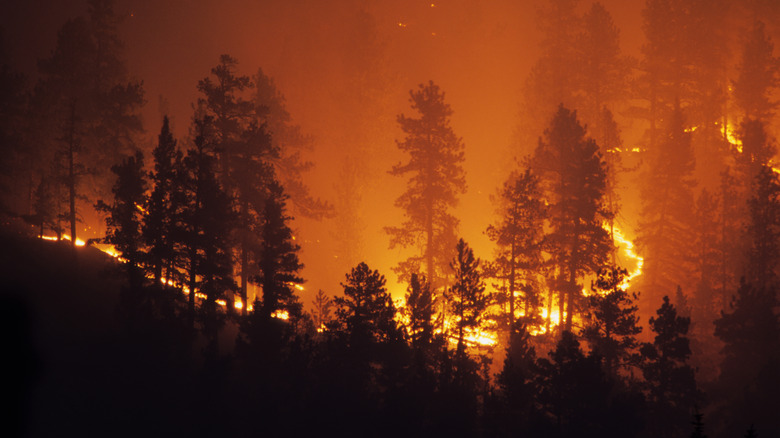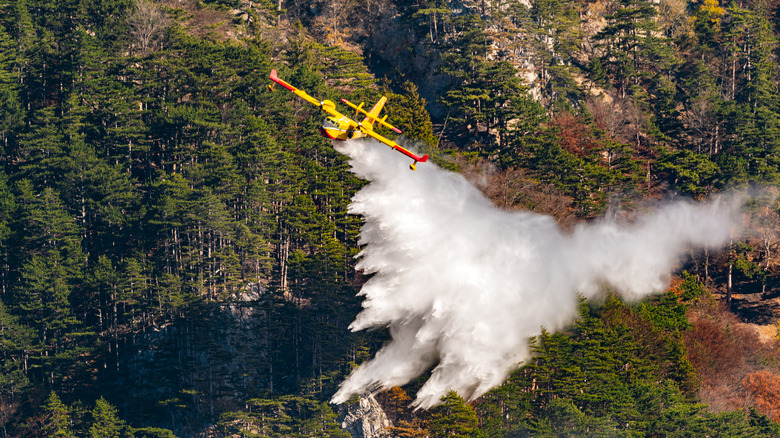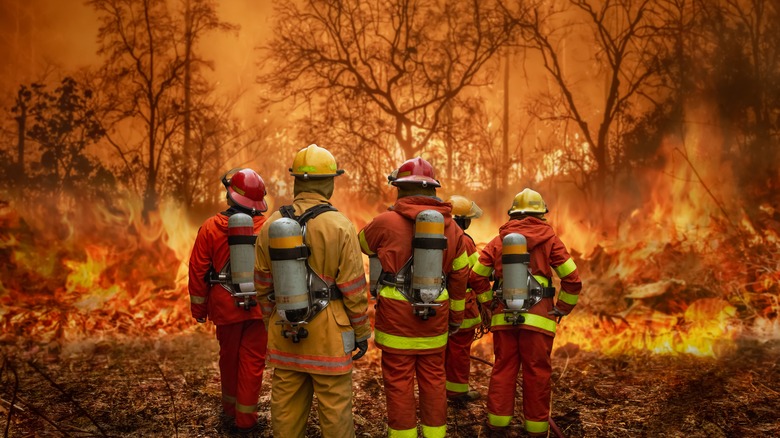You Won't Believe How Quickly Wildfires Can Travel Across A Forest
Wildfires have always been a tremendous threat, and the changing climate is surely exacerbating this issue. In July 2023, the BBC reported that Kyriakos Mitsotakis, the Greek Prime Minister, announced that his nation was "at war and ... exclusively geared towards the fire front" as more than 80 such blazes stormed across the country. The very next month, The Independent noted Maui's own inferno was declared "the worst natural disaster that Hawaii ever faced" by Josh Green, the state governor of Hawaii.
The defining and most horrifying element of a wildfire is the sheer scale of it. This is why it can take an enormous team of professional fire crews working in tandem, along with legions of volunteers, to attempt to subdue them. Like any fire, though, they can begin from the smallest spark: the infamous Carr Fire was started by an unfortunate vehicle creating sparks when it scraped a road. Though natural events like lightning strikes can cause such fires, humans have a part to play too. The battle then becomes how to contain the rapid growth of the emerging fire because it can happen outrageously quickly.
Here's how fast wildfires can grow across a forest and the techniques firefighters use in their battle against them.
Just how fast can wildfires travel?
Wide areas of forest, sadly, are just the sorts of places that provide potential wildfires with copious amounts of fuel. When they catch hold, just like any fire, they can spread relentlessly and frighteningly quickly.
According to Mercury Insurance information from the Western Fire Chiefs Association, wildfires typically travel at around 14.3 miles per hour. That's about a mile every four minutes and 20 seconds. Grassy areas are easier for fires to spread across, but in forests, they can still zoom along at six miles per hour. In September 2017, the Eagle Creek wildfire (started by a carelessly-thrown firework) traveled across 30,000 acres of land in around four days.
Naturally, the speed of a given fire will depend on a wide range of factors, from the wind direction and general weather conditions as it develops to the changing ground it burns through. One thing's certain, though — six miles per hour may sound like a modest speed, but considering that an average walking pace is about 3–4 miles per hour, wildfires are formidable forces of nature to behold. With that in mind, here are some measures we take to try to mitigate their threat.
What do we do to attempt to tackle wildfires?
The February 2017 study "Human-started wildfires expand the fire niche across the United States," by Jennifer K. Balch et al., concluded that human activity was the cause of 84% of 1.5 million recorded wildfires. Preventative measures, then, are paramount.
The wide, majestic National Parks of the United States are in constant danger from wildfires. Monitoring our behaviors is one of the most effective means of protecting them from this. For example, in June 2021, the Sequoia & Kings Canyon National Parks maxed out its danger-limiting methods. The rules, which banned smoking and campfires anywhere in the parks, were implemented "to reduce our risk from unwanted human-caused fires during the hottest and driest part of the year," fire management officer Chief John Ziegler said. Careless campfires can be fire risks just as lithium-ion batteries can.
With their rapid spread, containing a wildfire isn't a simple matter of dousing it with an awful lot of water. Wildfires, affected by winds and other natural factors, are far from predictable. Firefighters do all they can to keep themselves safe, as well as everybody else. Attempts typically focus on isolating fires using a border around them, areas starved of fuel (dug out by firefighters) that the flames will struggle to expand beyond. The logistics of this mean that it's hard to predict just how large an area a fire will devastate in the meantime. They can be so fast, sadly.


